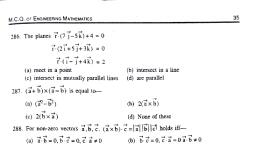Question 3 :
The phenomenon in which adsorption and absorption takes place simultaneously is called:
Question 5 :
Gold numbers of protective colloids <i>A, B, C</i> and <i>D</i> are 0.50, 0.01, 0.10 and 0.005, respectively. The correct order of their protective powers is
Question 6 :
At high concentration of soap in water, soap behaves as :-
Question 8 :
Decomposition of urea into <img style='object-fit:contain' src="https://storage.googleapis.com/teachmint/question_assets/NEET/5ead6a5541e6ca4117818ebe"> and <img style='object-fit:contain' src="https://storage.googleapis.com/teachmint/question_assets/NEET/5ead6a556694ca4eac0fce3e"> is followed by the action of enzyme :
Question 11 :
The addition of alcohol to a saturated aqueous solution of calcium acetate first forms a sol and then sets to a gelatinous mass called solid alcohol which is a :
Question 17 :
A precipitate is changed to colloidal solution by the following process
Question 20 :
Air can oxidize sodium sulphite in aqueous solution but cannot do so in the case of sodium arsenite. If however, air is passed through a solution containing both sodium sulphite and sodium arsenite then both are oxidized. This is an example of :
Question 21 :
Assertion: In chemisorption, adsorption keeps on increasing with temperature.
Reason: Heat keeps on providing more and more activation energy.
Question 22 :
The potential difference between the fixed charged layer and the diffused layer having opposite charge is called :
Question 25 :
Which acts as a promoter for nickel in the hydrogenation of oils?
Question 27 :
If {tex} \mathrm { x } {/tex} is amount of adsorbate and {tex} \mathrm { m } {/tex} is amount of adsorbent, which of the following relations is not related to adsorption process?
Question 29 :
<div>The activity of catalyst increases in finely divided state or colloidal state.<br/></div>
Question 30 :
The enzyme ptylin used for the digestion of food is present in
Question 31 :
The simplest way to check whether a system is colloidal is by __________.
Question 32 :
Starch converts into maltose by the catalytic action of the enzyme:
Question 33 :
Surface area available for adsorption per gram of catalyst is called :<br/>
Question 35 :
Which kind of catalysis can be explained on the basis of adsorption theory?
Question 37 :
Assertion: A catalyst is more effectively in finely divided form.
Reason: Finely divided form has more surface area.
Question 39 :
When a substance comes in colloidal state the surface area of the particles
Question 42 :
Assertion: Activity of an enzyme is pH-dependent.
Reason: Change in pH affects the solubility of the enzyme in water.
Question 45 :
In which of the following processes, a catalyst is not used? <br/>
Question 46 :
In endothermic reaction with the increase of temperature adsorption will be :
Question 47 :
What is a homogeneous solution with intermediate particle size between a solution and a suspension?
Question 48 :
Assertion: A catalyst does not alter the equilibrium constant of the reaction.
Reason: The catalyst forms a complex with the reactants and provides an alternate path with the lower energy of activation for the reaction; the forward and backward reactions are affected to the same extent.
Question 50 :
<div>Consider the following statements and arrange in the order of true/false as given in the codes.<br/></div>$S_1: $ The rate of the reaction A $\rightarrow$ B having the rate law $- \displaystyle \frac{d[A]}{dt} = k [A] [B]$ when plotted against time will exhibit a maximum at some time.<br/>$S_2: $ A catalyst in a chemical reaction increases the forward E$_a$ and decreases the backward $E_a$<br/>$S_3: $ A catalyst in a chemical reaction decreases both forward and backward $E_a$<br/>$S_4: $ For a first-order reaction, the time required to reduce successively the concentration of reactant by a constant fraction is always same.<br/>
Question 55 :
For a given reaction, energy of activation for forward reaction $(E_{af})$ is $80kJ.mol^{-1}.$ $\Delta H = -40kJ.mol^{-1}$ for the reaction. A catalyst lowers $E_{af}$ to $20 kJ.mol^{-1}.$ The ratio of energy of activation for reverse reaction before and after addition of catalyst is :<br/>
Question 56 :
Select the correct statement(s).<br/>1. Adsorption is spontaneous at all the temperatures.<br/>2. Gases having high critical temperature possess more tendency for adsorption.<br/>3. An adsorbent possesses more tendency for adsorption if it is in colloidal state.<br/>4. Chemical adsorption first decreases with increase in temperature and then increases.<br/>5. Water molecules are adsorbed in $CaCl_2(s)$ results in increasing temperature.<br/>





























